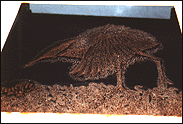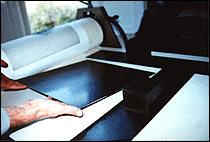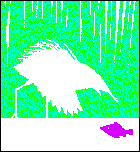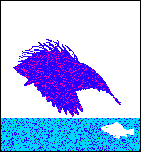 |
 |
Colour etchings are obtained by making two or three plates, each holding different elements of the image and inked in a number of colours. The paper is passed backwards and forwards through the press, each time with a different plate. Sometimes when the print is dry, a little hand tinting with water colour is necessary to complete the image.
I begin with three identical sheets of steel. The surface of the first plate is de-greased with a solution of whiting and dilute ammonia. The plate is heated, then using a roller an acid resistant hard wax is applied. To make it easier to see the drawing the wax is darkened with soot by holding the plate over the flame of burning tapers. Consequently, marks made on the plate show up as silver lines on a dark back ground. These lines will eventually print black, so in effect the drawing is like a black and white film negative.
 |
 |
When the drawing is complete the plate is immersed in a solution of nitric acid and bitten for a few minutes then removed. Parts of the drawing are covered with an acid resistant stopout varnish and the plate is returned to the acid for a further period of biting. After a time it is removed again and other areas are `stopped out’. This process is repeated until different parts of the drawing have been bitten to a variety of depths, causing some areas to print darker than others. This first plate is called the key plate because it holds all the details of the image and the other colour plates will be made to register with it.
After the acid resist is cleaned from the plate a print is made. The inked key plate and damp paper are run though the press, leaving one end of the paper trapped under the roller. Registration blocks are placed along two edges of the plate before it is removed from the bed allowing the blank plate to be placed exactly. The blocks are removed and the wet print is re-positioned over the new plate. Both are run through the press, causing a ghost of the image to be transferred from the paper to the plate. Now I know exactly where the different elements of the key drawing are and have a guide for registering the work to be done on this second plate. This process is then repeated with the third plate.
 |
 |
Most of my colour etchings are made using steel because, unlike copper and zinc, when a large open area of the metal is exposed to acid the surface is left pitted and grainy, perfect for holding ink. In this way, depending on the length of bite, a whole variety of tones are made. By working into these areas with burnishers, scrapers, wire wool and sandpaper, soft tonal gradations can be obtained. (It is possible to achieve a similar effect using copper or zinc but a granular acid resist, called aquatint, has to be applied to the plate before it is immersed in acid) All three plates are worked and re-worked. Some areas are adjusted or remove and prints or `proofs’ are made to test the progress at different stages before the final image is arrived at.
When I’m satisfied the work on the three plates is complete, I begin printing the edition. From inking up the plates to pulling the print takes about forty five minutes. Therefore, great care has to be taken with the inking procedure. The plate holding the areas of the reeds and fish is inked with two colours, green and purple. The next plate to be inked also holds two colours blue for the bird and green-blue for the water. The key plate is inked with one colour, sepia.
 |
 |
 |
 |
The reeds and fish are printed first. Then the paper is peeled away keeping one end trapped under the roller. The plate is removed and replaced, within the registration marks, with the second plate. Which holds the colours for the bird and water. The key plate is printed last because it holds all the drawing details and ties the image together. It also creates extra colour values by virtue of overprinting.
When all five colours have been printed the image is placed between sheets of acid free tissue and blotting paper for two or three days allowing it to dry flat. Finally the sky is hand-tinted with yellow water colour, the legs of the bird being tinted orange.